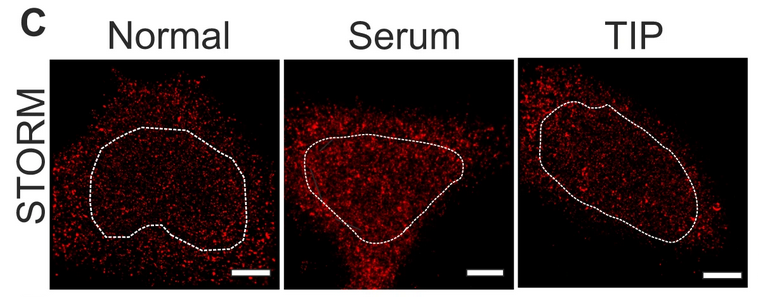
A paper involving Octopus that describes how certain natural processes regulate mRNA production, also known as gene expression, has just been published in Nature Communications. Gene expression is a fundamental cellular process whose mis-regulation drives the onset of cancer.
The multi-national team of scientists focused on understanding how certain proteins interact during the process of mRNA production, which prevents unwanted changes in gene expression.
The team, which consisted of collaborators from the CLF, The University of Sheffield, the Advanced Imaging Centre at Janelia Research Campus (USA) and Universität Ulm (Germany), used the CLF's super-resolution STORM imaging to help investigate how Myosin VI (a molecular engine that drives certain cell functions) impacts RNA Polymerase II (a complex that synthesises mRNA from DNA).
Looking at the results from their experiment, the team suggests that Myosin VI uses its ability to act as a molecular actin anchor to physically hold RNAPII at transcription sites – a process that can help to correctly regulate the timing of gene expression.
Learning more about how this process works could lead to future treatments or preventative measures that could deter unwanted changes in gene expression, preventing cell damage that could lead to cancers.
Head of Octopus and collaborator on the experiment, Prof Marisa Martin-Fernandez, said,
“Pioneering work led by Dr Chris Toseland has revealed that nuclear myosin VI plays a fundamental role by anchoring the RNA polymerase to DNA to allow its transcription. CLF-Octopus is proud to have contributed super-resolution imaging methods to aid the completion of this superb piece of science."
Octopus Link Scientist, Prof Lin Wang, said,
“Super-resolution Stochastic Optical Reconstruction Microscopy (STORM) at CLF's Octopus facility played a key role in this study. Using STORM, we were able to bypass the classic diffraction limit in optical microscopy, and access the fine details of Myosin VI and RNAPII distribution and organisation at the molecule level. Furthermore, the quantitative analysis results from STORM imaging revealed how Myosin VI activity contributes to the spatial organisation of RNAPII. This was another successful case in which the cutting-edge microscopy helps advance our understanding in molecular biology, built on the close collaboration between CLF and our user community."
Lead Scientist, Dr. Chris Toseland, said,
“This work provides a substantial insight in to the regulation of gene expression within our cells. Access to the CLF allowed us to perform Super-resolution imaging at a scale not possible in standard facilities so that we can dissect the molecular mechanism governing the role of myosin VI's interaction with RNA Polymerase II."
The study was also selected several months ago as a preprint highlight by PreLights – further attesting to its impact.
Read the paper here.
Image: Example STORM render images of MVI under normal, serum+ and
TIP-treated conditions (scale bar 2 μm). Dotted lines represent a region
of interest (ROI) containing the nucleus which are taken forward for
cluster analysis. The nucleus was identified using either Hoechst or
RNAPII staining. Nature Communications (Nat Commun)
ISSN 2041-1723 (online)
